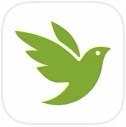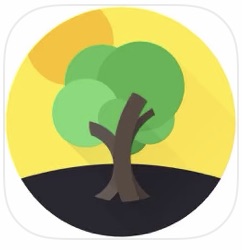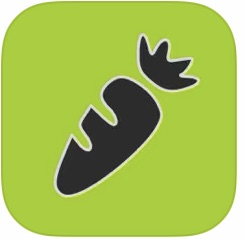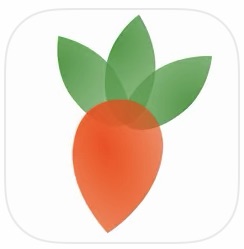There’s an App for That: 2021 Guide
By Janet Scheren, Fairfax Master Gardener Intern
With the proliferation of apps available on the IOS and Android platforms, there is no surprise that gardening apps abound. Master Gardeners often pull out their smartphones as a key resource in answering questions during farmers market consultations. Whether it’s identifying a plant, adding native plants to your garden or removing invasive ones, as well as addressing environmental concerns or planning a garden, there’s an app for that! Here are a few highly rated apps covering a range of needs.
Plant ID and Information
Three of the most popular apps for plant identification are LeafSnap, iNaturalist and PlantSnap. All allow you to snap a photo of the plant and get instant recognition of 90 percent of all known species of plants and trees. And all are now available for IOS or Android devices.
 LeafSnap, now also for Android as well as iOS, continues to be a widely used and powerful app for gardeners. In addition to plant ID, the listings provide information from watering frequency to pest and disease control, and from literature to fun facts.
LeafSnap, now also for Android as well as iOS, continues to be a widely used and powerful app for gardeners. In addition to plant ID, the listings provide information from watering frequency to pest and disease control, and from literature to fun facts.
 iNaturalist, a collaboration of the California Academy of Sciences and National Geographic, helps you identify plants via its database as well as crowdsourcing. This app also helps to build a database of where plants occur. It builds a community where scientists and naturalists can share their observations to help better understand and preserve nature.
iNaturalist, a collaboration of the California Academy of Sciences and National Geographic, helps you identify plants via its database as well as crowdsourcing. This app also helps to build a database of where plants occur. It builds a community where scientists and naturalists can share their observations to help better understand and preserve nature.
 PlantSnap has over 650,000 plants, mushrooms or succulents and more in its searchable database, with more added each month. Open the app and let it guide you to snapping a good shot of a plant. You’ll get an ID in seconds. Click on the thumbnail to get more information on the plant or find an online source to purchase it. PlantSnap is partnering with Snapchat to map every plant species on the planet by 2022. PlantSnap can help you evaluate a plant’s health or explore plants worldwide, then build a library of all the plants you’ve photographed.
PlantSnap has over 650,000 plants, mushrooms or succulents and more in its searchable database, with more added each month. Open the app and let it guide you to snapping a good shot of a plant. You’ll get an ID in seconds. Click on the thumbnail to get more information on the plant or find an online source to purchase it. PlantSnap is partnering with Snapchat to map every plant species on the planet by 2022. PlantSnap can help you evaluate a plant’s health or explore plants worldwide, then build a library of all the plants you’ve photographed.
 Wild Bee ID helps you identify bees and bee-friendly plants to create a pollinator garden and learn about protecting these critical species. While North America boasts more than 4,000 native bee species, most Americans are unaware of their existence or fundamental role in our ecosystems and food webs. Due to the loss of meadows and other natural habitats, our residential gardens have become an even more critical habitat for many bee species. These adaptive pollinators are always on the lookout for urban and suburban real estate. Even a small pollinator garden will be buzzing with these native species and can help ensure the survival of our native bees.
Wild Bee ID helps you identify bees and bee-friendly plants to create a pollinator garden and learn about protecting these critical species. While North America boasts more than 4,000 native bee species, most Americans are unaware of their existence or fundamental role in our ecosystems and food webs. Due to the loss of meadows and other natural habitats, our residential gardens have become an even more critical habitat for many bee species. These adaptive pollinators are always on the lookout for urban and suburban real estate. Even a small pollinator garden will be buzzing with these native species and can help ensure the survival of our native bees.
Environment
 Flora of Virginia mobile app puts all the contents of the printed volume into your pocket and keeps you up-to-date on new and renamed species. It is the most up-to-date information ever compiled on Virginia plants. Most species’ descriptions contain several photographs. Treatments of rare or threatened species include conservation ranks, and invasives are scored by their level of invasiveness. The county-by-county range maps are now color-coded as well as native or nonnative plants. The app costs $19.99. The hard copy book is $89.99.
Flora of Virginia mobile app puts all the contents of the printed volume into your pocket and keeps you up-to-date on new and renamed species. It is the most up-to-date information ever compiled on Virginia plants. Most species’ descriptions contain several photographs. Treatments of rare or threatened species include conservation ranks, and invasives are scored by their level of invasiveness. The county-by-county range maps are now color-coded as well as native or nonnative plants. The app costs $19.99. The hard copy book is $89.99.
 Rain Garden app developed by the University of Connecticut may have limited interest, but if you’re planning a rain garden it’s really useful. You can search its plant catalog to find the type of plant(s) — fern, grass, perennial, rush, sedge, shrub or tree — you’d like to include in your rain garden. Search sun exposure, bloom color, key word and then select the state of Virginia. It includes information on how to select the site and size of the garden, how to choose plants and how to install and maintain your rain garden. There are links to instructional videos.
Rain Garden app developed by the University of Connecticut may have limited interest, but if you’re planning a rain garden it’s really useful. You can search its plant catalog to find the type of plant(s) — fern, grass, perennial, rush, sedge, shrub or tree — you’d like to include in your rain garden. Search sun exposure, bloom color, key word and then select the state of Virginia. It includes information on how to select the site and size of the garden, how to choose plants and how to install and maintain your rain garden. There are links to instructional videos.
 TreeSnap was developed to enlist the help of concerned citizens in collecting data for scientists to use in critical research, such as the genetic diversity of tree species or how to build a better tree breeding program. The Chestnut Foundation, for example, is looking for healthy American chestnut trees in the wild to learn how these individuals are fully or partially resistant to the Chinese blight. They are using that information in a multi-pronged effort, including traditional breeding techniques, genetic modification and reduction of fungal virulence, to create a disease-resistant American chestnut that can once again thrive as the largest and most productive tree in our eastern U.S. landscape. Other trees of special interest include the American elm, ash, white oak, hemlock, Eastern larch, Pacific madrone, tanoak, Florida torreya, butternut and pinyon pine. This app helps you document the location of trees in your community, on your property or in the wild for further study by scientists. This free app was developed as a collaborative effort by the University of Tennessee, Knoxville and University of Kentucky with partial funding from the NSF Plant Genome Research Program.
TreeSnap was developed to enlist the help of concerned citizens in collecting data for scientists to use in critical research, such as the genetic diversity of tree species or how to build a better tree breeding program. The Chestnut Foundation, for example, is looking for healthy American chestnut trees in the wild to learn how these individuals are fully or partially resistant to the Chinese blight. They are using that information in a multi-pronged effort, including traditional breeding techniques, genetic modification and reduction of fungal virulence, to create a disease-resistant American chestnut that can once again thrive as the largest and most productive tree in our eastern U.S. landscape. Other trees of special interest include the American elm, ash, white oak, hemlock, Eastern larch, Pacific madrone, tanoak, Florida torreya, butternut and pinyon pine. This app helps you document the location of trees in your community, on your property or in the wild for further study by scientists. This free app was developed as a collaborative effort by the University of Tennessee, Knoxville and University of Kentucky with partial funding from the NSF Plant Genome Research Program.
Kitchen Gardens
 My Potager helps you to manage your kitchen garden. It provides information for both novice and experienced gardeners on more than 70 vegetables, flowers or herbs. In addition to plant descriptions, it provides a tool to plan your complete garden over the year. In addition to a detailed description, it includes a calendar view showing the seeding and/or planting dates, harvest dates and moon dates to perfectly grow your vegetables. It allows you to manage several garden plots from 1 x 1 feet to 9 x 9 feet. For iPhones and iPads.
My Potager helps you to manage your kitchen garden. It provides information for both novice and experienced gardeners on more than 70 vegetables, flowers or herbs. In addition to plant descriptions, it provides a tool to plan your complete garden over the year. In addition to a detailed description, it includes a calendar view showing the seeding and/or planting dates, harvest dates and moon dates to perfectly grow your vegetables. It allows you to manage several garden plots from 1 x 1 feet to 9 x 9 feet. For iPhones and iPads.
 Veggie Garden Planner helps you plan a vegetable garden patch, helping you choose vegetables that will grow well together, sowing and harvest times for each and good crop rotation patterns adjusted to your climate zone. It also provides a Patch Plan Editor, which lets you visually arrange your vegetable patch.
Veggie Garden Planner helps you plan a vegetable garden patch, helping you choose vegetables that will grow well together, sowing and harvest times for each and good crop rotation patterns adjusted to your climate zone. It also provides a Patch Plan Editor, which lets you visually arrange your vegetable patch.
Resources
Smartphone Apps for Virginia Gardeners, Suzanne Hamilton, Fairfax Master Gardener